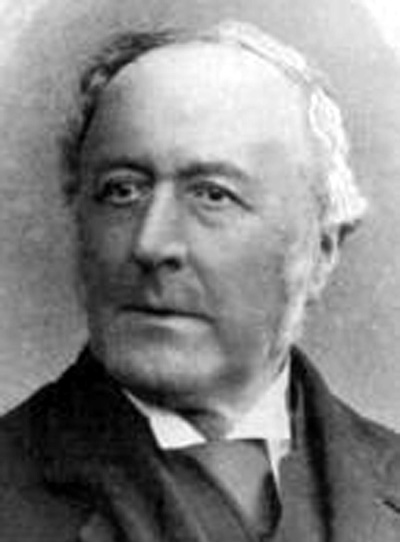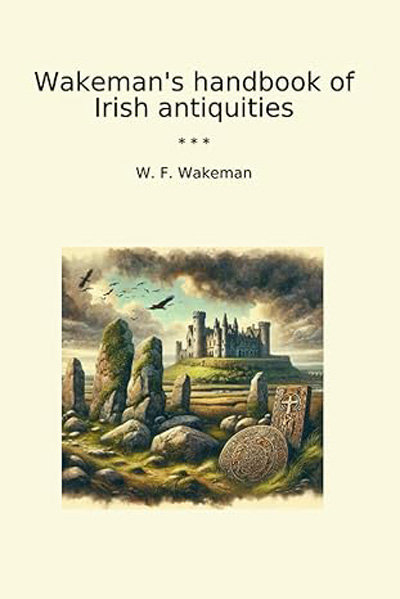William Frederick Wakeman (1822–1900)
 William
Wakeman (1822–1900) was a distinguished Irish antiquarian, archaeologist, and artist, often hailed as a pivotal figure in the development of archaeology in Ireland.
Born in Dublin, Wakeman dedicated his career to exploring and documenting Ireland's rich archaeological heritage.
William
Wakeman (1822–1900) was a distinguished Irish antiquarian, archaeologist, and artist, often hailed as a pivotal figure in the development of archaeology in Ireland.
Born in Dublin, Wakeman dedicated his career to exploring and documenting Ireland's rich archaeological heritage.
His detailed drawings, writings, and surveys of ancient monuments and artifacts significantly advanced the understanding and preservation of Ireland's historical landscape. Wakeman's work, characterized by its accuracy and thoroughness, laid the groundwork for future archaeological studies and earned him a lasting reputation as a key contributor to the field.
His Handbook of Irish Antiquities, is a seminal work in the field of Irish archaeology. First published in 1848, this comprehensive guide provides detailed descriptions and illustrations of Ireland's ancient monuments and artifacts. Wakeman's meticulous research and clear, accessible writing made the book an invaluable resource for scholars and enthusiasts alike. Through this handbook, Wakeman aimed to foster a deeper appreciation and understanding of Ireland's rich archaeological heritage.
William Frederick Wakeman | Irish Antiquary and Artist
William Wakeman holds a unique place in the history of Irish antiquarian studies and art. His life was a tapestry of exploration, artistic expression, and dedication to preserving Ireland's ancient monuments and cultural heritage.Born in 1822 in Dublin, Wakeman was the son of a bookseller and publisher from Nottingham, England. From a young age, he was immersed in a world of books and knowledge, which undoubtedly influenced his future career. By the age of 15, he was a drawing pupil of George Petrie, a significant figure in Irish antiquarian studies and the superintendent of the topographical department of the ordnance survey of Ireland. Under Petrie's mentorship, Wakeman developed a deep appreciation for Ireland's historical landscapes and artifacts.
At 17, Wakeman became a draughtsman and assistant in the topographical division of the ordnance survey, working alongside John O'Donovan. Together, they traveled extensively across counties Clare, Galway, Kilkenny, Tipperary, Waterford, and Wexford, documenting and drawing ancient monuments. These travels were not only adventurous but also pivotal in preserving Ireland's rich heritage. Much of Wakeman's work from this period is now housed in the Royal Irish Academy.
When the ordnance survey's topographical department disbanded in 1842, Wakeman briefly worked in Dublin as a draughtsman and watercolour painter. His talent earned him recognition, and he won a prize for an engraving. He then moved to London, where he spent four years as an art student. Despite his time in London, his heart remained in Ireland, and he returned to become an art master at St. Columba's School in Stackallen in County Meath, near the Boyne Valley monuments at Newgrange and Dowth.
During his tenure at St Columba's, Wakeman resumed his passion for antiquities. He visited and sketched numerous historical sites in the area, including the drained crannog of Lagore. His dedication culminated in the first edition of Archaeologia Hibernica: A Handbook of Irish Antiquities, Pagan and Christian in 1848. This work, illustrated with his on-location drawings, became a cornerstone for students and enthusiasts of Irish history.
After four years, St Columba's School relocated to Rathfarnham, Co. Dublin, and Wakeman took up a position as an art master at Portora Royal School in Enniskillen, Co. Fermanagh. He spent nineteen years there, a period marked by prolific creativity and teaching. His residence, named ‘Crannog,’ still stands opposite the school, a testament to his lasting impact.
Wakeman also taught at the district national model school in Enniskillen and exhibited frequently with the Royal Hibernian Academy. His works, primarily watercolours, captured the beauty of abbeys, castles, and natural landscapes, not only in Ireland but also in London and Yorkshire.
Wakeman's contributions were not confined to drawings and paintings. He wrote fifty articles for various journals, particularly those of the Royal Historical and Archaeological Association of Ireland. His subjects ranged from crannogs and early ecclesiastical sites to megalithic rock art and artifacts. He also illustrated numerous guides and books, including Ireland, its Character and Scenery (1841) by Mr. and Mrs. Samuel Carter Hall, and Lake Dwellings of Ireland (1886) by William Gregory Wood-Martin.
Legacy and Recognition
William Frederick Wakeman's life was marked by a profound dedication to Irish antiquities and art. However, his contributions were not fully recognized during his lifetime, possibly due to social class differences. Despite this, his work remains invaluable to the field of Irish archaeology and art history.Wakeman died in 1900 at his daughter's house in Coleraine, Co. Derry. He is buried near Portrush, Co. Antrim, with a Celtic cross marking his grave. His artifacts and many original sketches and drawings are preserved in The Royal Irish Academy and other museums. After his death, his son Gerald continued his legacy as an archaeological illustrator.
Wakeman's life and work continue to inspire those passionate about Ireland's rich cultural and historical heritage. His meticulous documentation and artistic portrayal of ancient sites offer a window into Ireland's past, ensuring that future generations can appreciate and learn from the country's storied history.
Editions of Wakeman's Handbook of Irish Antiquities
First Edition: Published in 1848.Second Edition: Enlarged edition published in 1891.
Third Edition: Published in 1903, posthumously.
Each edition built upon the previous one, incorporating more of Wakeman's extensive research and illustrations of Irish antiquities.
 Wakeman's handbook of Irish antiquities
is a comprehensive guide to the rich history and culture of Ireland. Written by prolific author and writer William Frederick Wakeman,
this classic book is a must-have for anyone interested in the ancient and medieval heritage of the Emerald Isle.
Wakeman's handbook of Irish antiquities
is a comprehensive guide to the rich history and culture of Ireland. Written by prolific author and writer William Frederick Wakeman,
this classic book is a must-have for anyone interested in the ancient and medieval heritage of the Emerald Isle.
The handbook covers a wide range of topics, including prehistoric monuments, ancient burial sites, medieval churches, castles, and monastic settlements. Wakeman provides detailed descriptions and explanations of each site, drawing on his extensive knowledge of Irish archaeology and history. What sets this book apart is Wakeman's engaging writing style and his ability to bring the past to life. He delves into the myths and legends surrounding the sites, providing fascinating insights into the beliefs and traditions of the ancient Irish people.
Whether you are planning a trip to Ireland or simply want to delve into its rich history from the comfort of your armchair, Wakeman's handbook of Irish antiquities is an invaluable resource. It is a timeless classic that will continue to inspire and educate readers for generations to come.
Purchase at Amazon.com or Amazon.co.uk
Boyne Valley Private Day Tour
 Immerse yourself in the rich heritage and culture of the Boyne Valley with our full-day private tours.
Visit Newgrange World Heritage site, explore the Hill of Slane, where Saint Patrick famously lit the Paschal fire.
Discover the Hill of Tara, the ancient seat of power for the High Kings of Ireland.
Book Now
Immerse yourself in the rich heritage and culture of the Boyne Valley with our full-day private tours.
Visit Newgrange World Heritage site, explore the Hill of Slane, where Saint Patrick famously lit the Paschal fire.
Discover the Hill of Tara, the ancient seat of power for the High Kings of Ireland.
Book Now
Home
| Visitor Centre
| Tours
| Winter Solstice
| Solstice Lottery
| Images
| Local Area
| News
| Knowth
| Dowth
| Articles
| Art
| Books
| Directions
| Accommodation
| Contact
